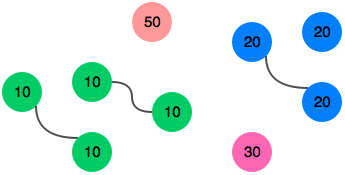There is a large pile of socks that must be paired by color. Given an array of integers representing the color of each sock, determine how many pairs of socks with matching colors there are.
Example
There is one pair of color and one of color . There are three odd socks left, one of each color. The number of pairs is .
Function Description
Complete the sockMerchant function in the editor below.
sockMerchant has the following parameter(s):
- int n: the number of socks in the pile
- int ar[n]: the colors of each sock
Returns
- int: the number of pairs
Input Format
The first line contains an integer , the number of socks represented in .
The second line contains space-separated integers, , the colors of the socks in the pile.
Constraints
- where
Sample Input
STDIN Function
----- --------
9 n = 9
10 20 20 10 10 30 50 10 20 ar = [10, 20, 20, 10, 10, 30, 50, 10, 20]
Sample Output
3
Explanation

There are three pairs of socks.
Solution:
#include <bits/stdc++.h>
using namespace std;
string ltrim(const string &);
string rtrim(const string &);
vector<string> split(const string &);
/*
* Complete the 'sockMerchant' function below.
*
* The function is expected to return an INTEGER.
* The function accepts following parameters:
* 1. INTEGER n
* 2. INTEGER_ARRAY ar
*/
int sockMerchant(int n, vector<int> ar) {
int cnt=0;
int i=0,j=0;
for(i=0;i<n;i++){
for(j=i+1;j<n;j++)
if(ar[i]<ar[j]){
cnt=ar[i];
ar[i]=ar[j];
ar[j]=cnt;
}
}
cnt=0;
for(i=0;i<n;i++){
j=i+1;
if((i==n)||(j>=n))
break;
if(ar[i]==ar[j]){
cnt++;
i=j;
}
}
cout << "total count:" <<cnt;
return cnt;
}
int main()
{
ofstream fout(getenv("OUTPUT_PATH"));
string n_temp;
getline(cin, n_temp);
int n = stoi(ltrim(rtrim(n_temp)));
string ar_temp_temp;
getline(cin, ar_temp_temp);
vector<string> ar_temp = split(rtrim(ar_temp_temp));
vector<int> ar(n);
for (int i = 0; i < n; i++) {
int ar_item = stoi(ar_temp[i]);
ar[i] = ar_item;
}
int result = sockMerchant(n, ar);
fout << result << "\n";
fout.close();
return 0;
}
string ltrim(const string &str) {
string s(str);
s.erase(
s.begin(),
find_if(s.begin(), s.end(), not1(ptr_fun<int, int>(isspace)))
);
return s;
}
string rtrim(const string &str) {
string s(str);
s.erase(
find_if(s.rbegin(), s.rend(), not1(ptr_fun<int, int>(isspace))).base(),
s.end()
);
return s;
}
vector<string> split(const string &str) {
vector<string> tokens;
string::size_type start = 0;
string::size_type end = 0;
while ((end = str.find(" ", start)) != string::npos) {
tokens.push_back(str.substr(start, end - start));
start = end + 1;
}
tokens.push_back(str.substr(start));
return tokens;
}